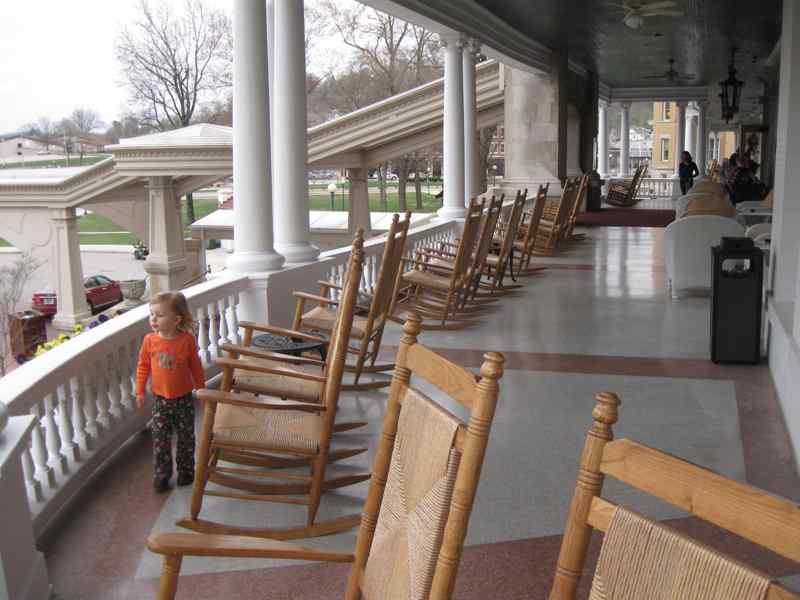Last week I spent several days in French Lick, staying in the impressive
French Lick Springs Hotel. The view below shows the Spring Wing from the courtyard. The hotel is large, with 443 room.
It has an elegant interior. When it was in its prime, early in the 20th century, it was the destination for wealthy people.
If you are on the floor shown above and look up, you see paintings on the ceiling like these.
On warm summer days these rocking chairs might be filled.
That girl above looks a lot like my friend
Betty.
Why is a luxury hotel located in a small, inaccessible town in Southern Indiana? It is because of the smelly water. Below you see the well for Pluto Water, a water so smelly that it makes one somewhat nauseous.It was touted as a cure for many things, but the one thing it actually did do was that it
moved bowels.
Apparently people a century ago suffered from a lot of constipation.
Pluto Water was bottled and sold nationally. Its popularity declined after World War II, and the last bottle of it was produced in 1972. The hotel entered a long period of decline as the popularity of its smelly water waned, and its current revival is based on the new casino that was built a few years ago.
Rensselaer also has sulfur water, and at one time, according to accounts I have read, there was a sulfur spring on the banks of the Iroquois River. It stopped flowing after the river was dredged and as far as I know, no traces of it remain. Maybe if some entrepreneur had developed it as a health spa, Rensselaer would have a big luxury hotel. Or maybe our water lacked the laxative quality that the water in French Lick has.
A mile north of the French Lick Springs Hotel is an even more impressive hotel, the
West Baden Hotel. It has a huge covered courtyard--when it was built, it was the world's largest free-span dome. The Great Depression and perhaps a change in tastes resulted in the closure of the hotel in the early 1930s. For thirty years it was a Jesuit seminary, and then a branch college of the Norwood Institute. After a number of years of vacancy, it was restored in the 1990s and early in the 21st century. You can read about the hotel and its history in a
long Wikipedia article.
The grounds have also been restored and are very attractive. Both of these hotels are run by the same company and there is a free shuttle between them.
In their prime, visitors to these two luxury hotels arrived via the
Monon Railroad. Some of the Monon tracks are still visible at the entrance to the West Baden Springs Hotel. The old Monon train depot still stands, and is the home of the
Indiana Railway Museum. It runs excursion trains, one of the tourists attractions of the area, but the trains do not go on old Monon tracks. Rather they go on tracks that were originally used by a small railroad to transport coal from Southern Indiana to French Lick, and from there to Chicago. A highlight of the excursion train is a tunnel more than 2000 feet long.
(Closer to home, North Judson has a
railroad museum that offers train rides. I have not visited it, but if I get the right grandkid at the right time, I may. Have any of you taken the North Judson train?)
Visitors today may find a newer hotel across the street from the French Lick Springs Hotel more attractive, the
Big Splash Adventure Indoor Water Park and Resort. The water park was my
introduction to French Lick last October.
And if Little Indiana ever visits, I recommend she take a look at the Black Buggy Amish Restaurant.

























































